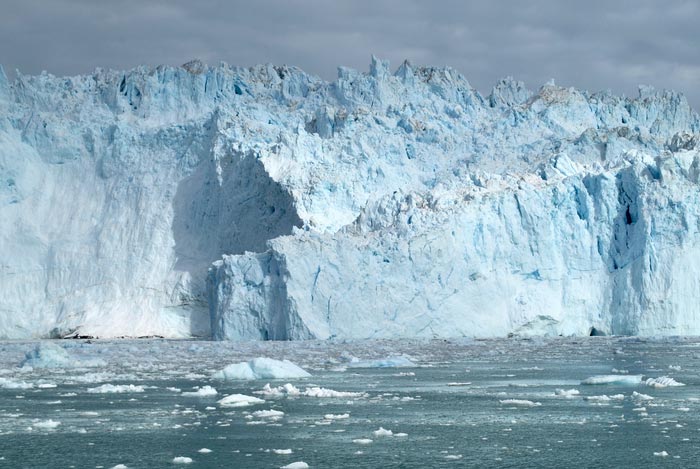Coastal glacier retreat linked to climate change

Eqip Sermia, like many coastal glaciers in Greenland, has retreated in the last two decades. New research from the University of Texas Institute for Geophysics and Georgia Tech provides a way to determine how much climate change is influencing large-scale glacial melting.
Credit: John Erich Christian/University of Texas Institute for Geophysics/Georgia Tech
More of the world’s coastal glaciers are melting faster than ever, but exactly what’s triggering the large-scale retreat has been difficult to pin down because of natural fluctuations in the glaciers’ surroundings. Now, researchers at the University of Texas Institute for Geophysics (UTIG) and Georgia Tech have developed a methodology that they think cracks the code to why coastal glaciers are retreating, and in turn, how much can be attributed to human-caused climate change. Attributing the human role for coastal glaciers – which melt directly into the sea – could pave the way to better predictions about sea level rise.
So far, scientists have tested the approach only in computer models using simplified glaciers. They found that even modest global warming caused most glaciers to melt, or retreat.
The next step, the researchers said, is for scientists to simulate the coastal glaciers of a real ice sheet, like Greenland’s, which holds enough ice to raise sea level by about 22 feet (7 meters). That will reveal whether they are retreating due to climate change and help predict when major ice loss might next occur.
“The methodology we’re proposing is a road map towards making confident statements about what the human role is [in glacial retreats],” said glaciologist John Christian, who is a postdoctoral researcher at both The University of Texas at Austin and Georgia Tech. “Those statements can then be communicated to the public and policymakers, and help in their decision making.”
Published July 13 in the journal The Cryosphere, the methodology is unique because it treats rapid glacier retreat as an individual probabilistic event, like a wildfire or tropical storm. For a large retreat to happen, the glacier must retreat past its “stability threshold,” which is usually a steep rise in the underlying bedrock that helps slow its flow. The probability of that happening varies depending on local climate and ocean conditions that change with natural fluctuations and human-caused warming. Even small variations can cause large changes in a glacier’s behavior, making them hard to predict and leading to cases where glaciers were found retreating right next to ones that weren’t.
That, said co-author and UTIG glaciologist Ginny Catania, is why the last Intergovernmental Panel on Climate Change report found there was still too much uncertainty about coastal glaciers to say whether their retreat is due to human-caused climate change or natural climate fluctuations.
The new study shows how to overcome the uncertainty by providing a methodology that accounts for differences between glaciers and natural climate fluctuations, while testing the effect of background trends such as global warming. According to Catania, the study means they can now attribute mass coastal glacier retreat to climate change and not just natural variability.
“And that’s the first time anyone’s done that,” she said.
To test the methodology, the team ran thousands of simulations of the past 150 years with and without global warming. The simulations showed that even modest warming dramatically increased the probability of ice sheet-wide glacier retreat.
When the scientists ran models without human-caused climate change, they found it virtually impossible for more than a few of the glaciers to begin retreating within years of each other.
By contrast, since 2000, nearly all (200) of Greenland’s 225 coastal glaciers have been in varying states of retreat.
“This study gives us a toolbox to determine the role of humans in the loss of ice from Greenland and Antarctica, to say with confidence that it’s not just coincidence,” said Georgia Tech glaciologist and co-author Alex Robel.
The research on coastal glaciers builds on previous work to understand the human role on the retreat of mountain glaciers — which is now well-established. The latest study was funded by UTIG and the National Science Foundation. UTIG is a research arm of UT Austin’s Jackson School of Geosciences.
Journal: The Cryosphere
DOI: 10.5194/tc-16-2725-2022
Method of Research: Computational simulation/modeling
Article Title: https://doi.org/10.5194/tc-16-2725-2022
Article Publication Date: 13-Jul-2022
Media Contact
Constantino Panagopulos
University of Texas at Austin
costa@ig.utexas.edu
Cell: 512-574-7376
Media Contact
All latest news from the category: Earth Sciences
Earth Sciences (also referred to as Geosciences), which deals with basic issues surrounding our planet, plays a vital role in the area of energy and raw materials supply.
Earth Sciences comprises subjects such as geology, geography, geological informatics, paleontology, mineralogy, petrography, crystallography, geophysics, geodesy, glaciology, cartography, photogrammetry, meteorology and seismology, early-warning systems, earthquake research and polar research.
Newest articles

Innovative 3D printed scaffolds offer new hope for bone healing
Researchers at the Institute for Bioengineering of Catalonia have developed novel 3D printed PLA-CaP scaffolds that promote blood vessel formation, ensuring better healing and regeneration of bone tissue. Bone is…

The surprising role of gut infection in Alzheimer’s disease
ASU- and Banner Alzheimer’s Institute-led study implicates link between a common virus and the disease, which travels from the gut to the brain and may be a target for antiviral…

Molecular gardening: New enzymes discovered for protein modification pruning
How deubiquitinases USP53 and USP54 cleave long polyubiquitin chains and how the former is linked to liver disease in children. Deubiquitinases (DUBs) are enzymes used by cells to trim protein…



